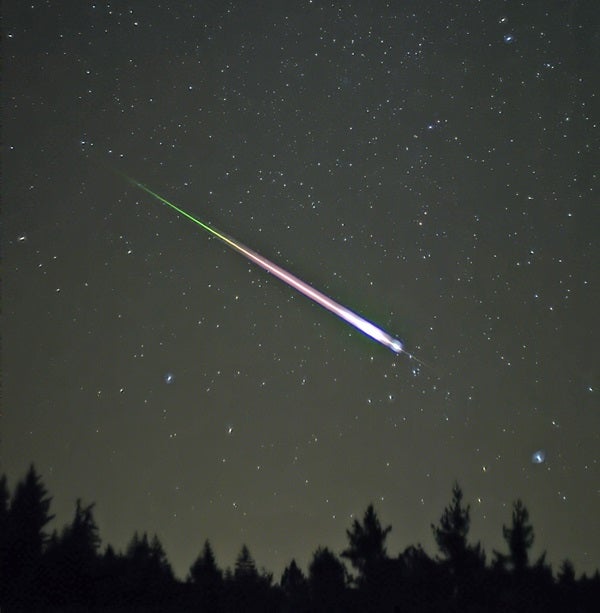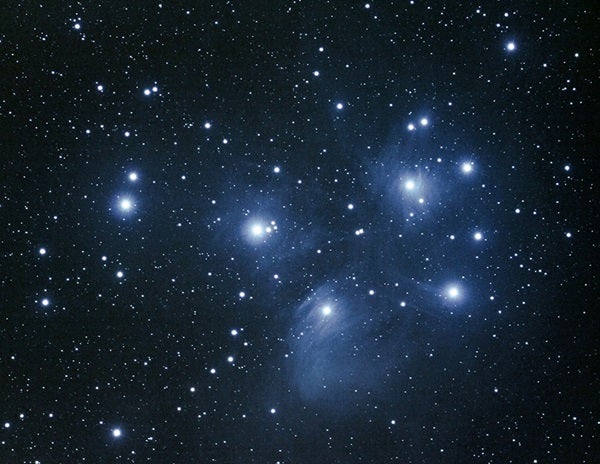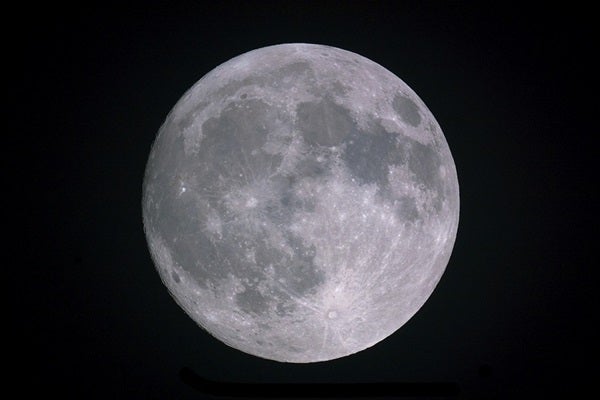Asteroid 3 Juno puts on a grand performance this week. Although it reaches opposition tomorrow evening, it appears just as bright tonight. Glowing at magnitude 7.4 — easy to spot with binoculars under a reasonably dark sky and a cinch to locate through a telescope — it appears brighter than it has since October 1983. You can find Juno floating among the relatively faint background stars of northern Eridanus the River. This evening, it lies 0.4° south-southwest of the magnitude 4.7 star 32 Eridani.
Saturday, November 17
The annual Leonid meteor shower peaks tonight. With the waxing gibbous Moon setting before 2 a.m. local time and morning twilight beginning after 5 a.m., skywatchers have more than three hours for undisturbed viewing. The meteors radiate from the constellation Leo the Lion, which climbs more than 60° high in the southeast before dawn. Observers under a dark sky could see an average of between 15 and 20 meteors per hour. Leonid meteors come from tiny dust particles ejected by periodic comet 55P/Tempel-Tuttle during its innumerable passes through the inner solar system. When these bits of debris slam into Earth’s atmosphere at 44 miles per second, friction with air molecules incinerates them and produces the bright streaks.
Sunday, November 18
If you are out before dawn viewing the Leonid meteor shower, you’ll be equally dazzled by Venus. The inner planet passed between the Sun and Earth just three weeks ago, but its rapid orbital motion has already brought it back to prominence. This morning, the planet rises 2.5 hours before the Sun and climbs 10° high in the east-southeast by the time morning twilight begins. Shining at magnitude –4.8, the brilliant world remains conspicuous even in bright twilight. Look carefully and you’ll also see 1st-magnitude Spica, Virgo the Maiden’s brightest star, less than 2° to the planet’s upper right. When viewed through a telescope, Venus displays a 50″-diameter disk that is just 14 percent illuminated.
Although the waxing gibbous Moon sheds a lot of light in the evening sky early this week, it doesn’t rule out viewing some deep-sky objects. One of autumn’s finest star clusters — in fact, one of the best in the entire sky — appears conspicuous in the east after darkness falls. The Pleiades star cluster (M45) in Taurus shines at magnitude 1.2, which is bright enough to pierce the veil of light pollution as well as anything the Moon can throw its way. The Pleiades is an outstanding naked-eye object, but it looks even more spectacular through binoculars. To find more objects worth exploring these autumn nights, see “November’s 50 finest deep-sky objects” in the November issue of Astronomy.
Tuesday, November 20
The days of viewing Saturn in the evening sky are dwindling rapidly. You can find the ringed world nearly 15° high in the southwest an hour after sunset. The planet shines at magnitude 0.6, more than a full magnitude brighter than any of the background stars in its host constellation, Sagittarius the Archer. Of course, the best views of Saturn come through a telescope, which reveals its 15″-diameter globe surrounded by a spectacular ring system that spans 35″ and tilts 26° to our line of sight.
Wednesday, November 21
Mars continues to put on a great show these November evenings. The Red Planet appears nearly 40° above the southern horizon once darkness falls. The world shines at magnitude –0.2, brighter than any other early evening object save for the Moon, against the faint backdrop of Aquarius the Water-bearer. A telescope reveals a disk that spans 10″ and should show some subtle surface features.
Thursday, November 22
The Full Moon lights up the Thanksgiving night sky from dusk to dawn. Earth’s only natural satellite officially reaches its Full phase at 12:39 a.m. EST tomorrow morning (9:39 p.m. PST this evening). You can find it rising in the east near sunset and peaking high in the south around midnight local time. It dips low in the west by the time morning twilight starts to paint the sky. The Moon spends the night in eastern Taurus, some 10° south of the Pleiades star cluster.
Although Thanksgiving weekend signifies autumn to many people, the stars of both summer and winter appear prominent in late November’s evening sky. If you head out around 9 p.m. local time and look toward the west, you’ll see the bright stars of the Summer Triangle. These three luminaries — Vega, Deneb, and Altair — stand out nicely. Deneb appears highest (nearly halfway to the zenith), while the brightest, Vega, lies farthest to the north. Now, if you turn around and face east, you’ll find stars normally associated with winter. Betelgeuse, Rigel, Aldebaran, and Capella all clear the horizon before 8 p.m. and appear conspicuous an hour later.
Saturday, November 24
While the stars of summer and winter remain on view these late November evenings, the stars of spring are not so lucky. The Big Dipper swings low in the north at this time of year. Although this conspicuous asterism never sets from much of the United States and Canada, it does come close. And the star at the end of the handle — magnitude 1.9 Eta () Ursae Majoris — does dip below the horizon around 9 p.m. local time for viewers south of 40° north latitude.
Sunday, November 25
Neptune’s westward motion against the background stars comes to a halt today. The distant planet appears highest in the south near the end of evening twilight and doesn’t set until around midnight. The magnitude 7.9 world lies in Aquarius, 2° due east of the 4th-magnitude star Lambda () Aquarii. You’ll need binoculars to spy Neptune and a telescope to see its blue-gray disk, which spans 2.3″.












